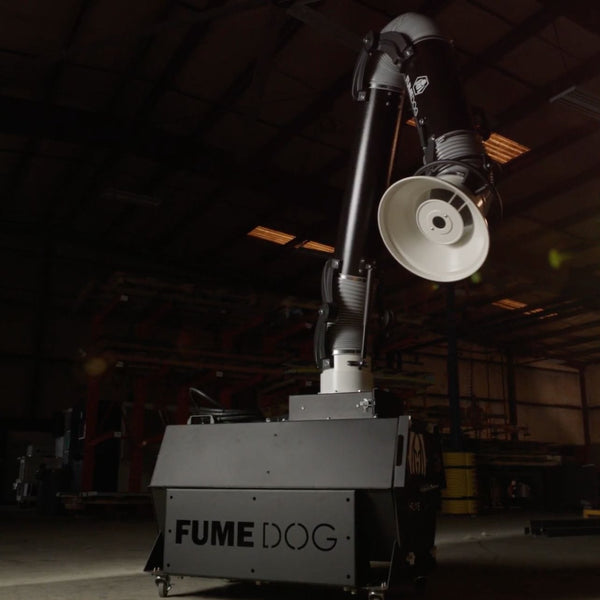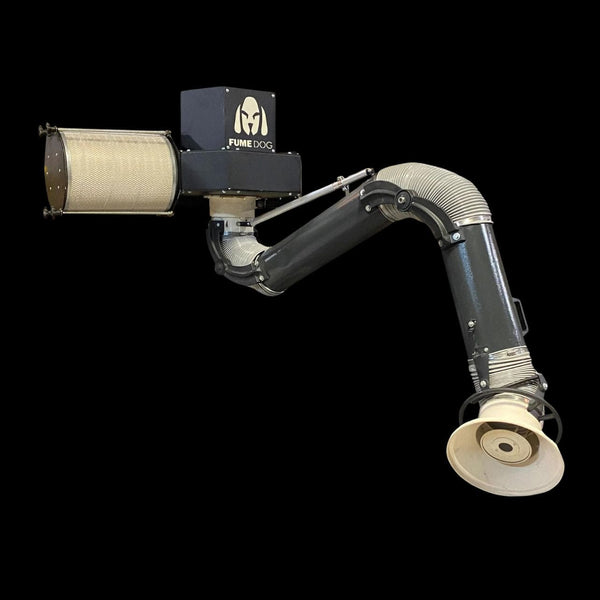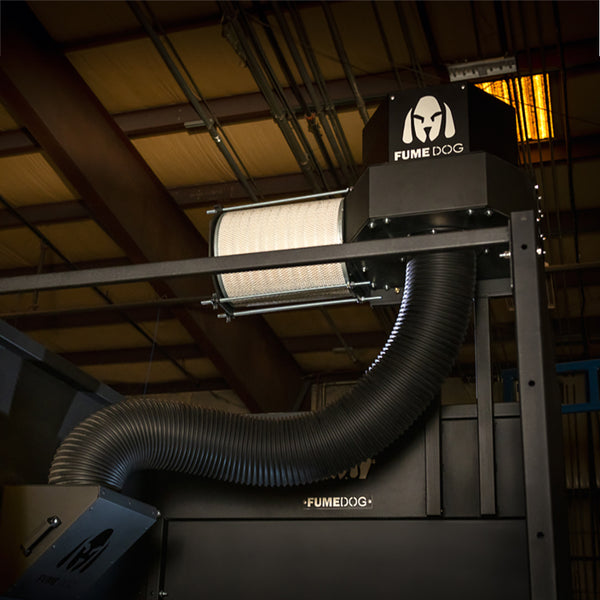
Welding galvanized steel might seem like any other welding job, but the dangers of welding galvanized steel are far more serious than most welders realize. When you heat galvanized metal, you're not just joining two pieces of steel—you're creating a toxic cocktail of zinc oxide fumes that can cause immediate illness and long-term health problems. From metal fume fever to potential nervous system damage, understanding these risks could save your life.
TLDR: Key Points
• Welding galvanized steel creates toxic zinc oxide fumes that cause metal fume fever and serious long-term health problems
• Proper preparation including mechanical removal of galvanized coating is essential before welding
• Adequate ventilation and respiratory protection are critical—standard dust masks won't protect you from zinc oxide fumes
• Professional fume extraction systems provide the most effective protection for regular galvanized steel welding
Protect Your Health with Professional Fume Extraction
Don't let the hidden dangers of welding galvanized steel put your health at risk. The toxic zinc oxide fumes created during these operations require serious protection that goes beyond basic safety measures. Professional welders who regularly work with galvanized materials need reliable, powerful fume extraction systems that capture dangerous particles at the source. Explore our complete selection of portable welding fume extractors designed specifically to handle the most challenging welding environments and keep you breathing clean air on every job.
What Makes Galvanized Steel So Hazardous to Weld?
Understanding the Galvanized Coating
Galvanized steel gets its corrosion resistance from a protective zinc coating applied to the base metal. This galvanized coating is what makes these materials so dangerous when heated during welding operations. The zinc coating, while excellent for preventing rust, becomes a serious health hazard when vaporized at welding temperatures.
When you're welding galvanized steel, the intense heat causes the zinc coating to vaporize, creating zinc oxide fumes that are invisible but extremely toxic. These aren't your typical welding fumes—they're a complex mixture of particles that can penetrate deep into your respiratory system.
The Hot Dip Galvanizing Process
The hot dip galvanizing process creates a metallurgical bond between the zinc and the base metal, making it impossible to simply scrape off the coating completely. This industrial process dips steel into molten zinc at temperatures around 860°F, creating multiple layers of zinc-iron alloys that provide superior corrosion protection but maximum danger when welded.
Understanding how this coating is applied helps explain why learning more about metal fume fever is crucial for anyone working with galvanized materials.
Welding Galvanized Metal: The Toxic Truth About Zinc Oxide Fumes

How Zinc Coating Creates Harmful Fumes
When welding galvanized materials, temperatures reach 2,000°F or higher—well above zinc's boiling point of 1,665°F. This causes the galvanized coating to vaporize instantly, creating zinc oxide fumes that are 10-15 times smaller than typical welding fumes. These microscopic particles easily bypass your body's natural filtration systems.
The toxic fumes generated during welding galvanized steel don't just dissipate—they linger in the air and can be inhaled hours after the welding stops. What makes these harmful fumes particularly dangerous is their ability to penetrate deeply into lung tissue, where they can cause both immediate and long-term damage.
The Complex Mixture of Toxic Substances Released
Welding galvanized steel creates more than just zinc oxide. You're dealing with a complex mixture that includes zinc chloride, zinc sulfate, and other zinc compounds. Each of these substances brings its own health risks, from respiratory irritation to potential carcinogenic effects.
For welders who want to understand more about toxic substances in welding, understanding if welding fumes are toxic provides essential information about the broader spectrum of welding-related health hazards.
Metal Fume Fever: The Most Common Health Risk
Recognizing the Symptoms
Metal fume fever is the most immediate and common health risk when welding galvanized steel. Symptoms typically appear 4-12 hours after exposure and feel remarkably similar to the flu. You might experience fever, chills, nausea, headaches, and fatigue. Many welders mistake these symptoms for a common cold and continue working, making the problem worse.
The zinc shakes—a specific type of metal fume fever caused by zinc oxide exposure—can cause severe muscle aches and weakness. These symptoms usually last 24-48 hours, but repeated exposure can lead to more severe and longer-lasting effects.
How Zinc Shakes Affect Your Nervous System
Zinc oxide fumes don't just affect your respiratory system—they can also impact your nervous system. High levels of zinc exposure can interfere with copper absorption in your body, leading to neurological symptoms including confusion, memory problems, and coordination issues.
Regular exposure to zinc oxide fumes from welding galvanized steel may contribute to long-term neurological damage, making proper protection absolutely critical for professional welders.
Long-Term Health Hazards of Welding Galvanized Steel

Respiratory System Damage
The health hazards extend far beyond metal fume fever. Chronic exposure to zinc oxide fumes can cause permanent lung damage, including pulmonary edema and chronic obstructive pulmonary disease (COPD). The microscopic particles from galvanized metal welding can scar lung tissue, reducing your breathing capacity permanently.
Professional welders who regularly work with galvanized materials without proper protection face significantly higher risks of developing serious respiratory conditions that can end their careers and threaten their lives.
Other Serious Health Risks
Beyond respiratory damage, the health risks include potential impacts on your immune system, kidney function, and cardiovascular health. Some studies suggest that chronic exposure to zinc oxide fumes may increase the risk of certain cancers, though more research is needed to establish definitive links.
The key is prevention—learning ways to minimize exposure to welding fumes can help protect you from these serious long-term consequences.
Essential Safety Measures for Welding Galvanized Materials
Proper Preparation Techniques
Proper preparation is your first line of defense against the dangers of welding galvanized steel. Remove as much of the galvanized coating as possible from the weld area using mechanical methods like grinding or wire brushing. This preparation work should be done in a well-ventilated area while wearing appropriate respiratory protection.
Chemical stripping agents can also remove galvanized coating, but these introduce their own health hazards and require careful handling. Mechanical removal remains the safest and most effective method for most applications.
Protective Equipment and Ventilation
Even with proper preparation, some galvanized coating will remain, making adequate ventilation absolutely critical. Local exhaust ventilation that captures fumes at the source is far more effective than general shop ventilation. The goal is to remove toxic fumes before they can be inhaled.
Personal protective equipment must include appropriate respiratory protection—standard dust masks won't protect you from zinc oxide fumes. You need respiratory equipment specifically rated for welding fumes and metal vapors.
For comprehensive protection, many professional welders invest in portable welding fume extractors that provide targeted fume removal exactly where it's needed most. These systems can dramatically reduce your exposure to toxic fumes and help prevent both immediate illness and long-term health problems.
Professional welding operations should also implement comprehensive safety protocols, including regular air quality monitoring and health screenings for workers regularly exposed to galvanized materials. For more detailed guidance, check out these tips for reducing common health hazards of welding fumes.
Frequently Asked Questions
What are welding fumes generally composed of?
Welding fumes generally contain a mixture of metal particles, gases, and chemical compounds that vary depending on the base materials, filler material, and welding process used. These fumes can include iron oxide, manganese, chromium, nickel, and other metallic particles that pose various health risks when inhaled.
How do welding and cutting processes affect fume production?
Different welding and cutting processes produce varying amounts and types of fumes. Arc welding processes typically generate more fumes than gas welding, while plasma cutting can produce particularly high concentrations of toxic particles. The specific welding process you choose directly impacts your exposure risk.
What welding gases should I be concerned about?
Beyond particulate fumes, welding produces various welding gases including carbon monoxide, nitrogen oxides, and ozone. These gases can cause respiratory irritation, oxygen displacement, and other serious health effects, especially in confined spaces or poorly ventilated areas.
Why do metal fumes pose such significant health risks?
Metal fumes are extremely small particles that can penetrate deep into lung tissue and even cross into the bloodstream. Unlike larger particles that your body can filter out naturally, these microscopic metal fumes bypass your natural defense mechanisms and can cause both immediate and long-term health problems.
How does a welding shield protect against ultraviolet light?
A properly fitted welding shield protects your eyes and face from harmful ultraviolet light emitted during welding operations. UV exposure from welding can cause "welder's flash" (similar to severe sunburn on your corneas) and long-term eye damage if proper protection isn't used consistently.
What shielding gases are safest to use?
Common shielding gases like argon and carbon dioxide are generally safe when used with proper ventilation, but some specialty gases can pose additional risks. Always ensure adequate ventilation regardless of the shielding gases used, as even inert gases can displace oxygen in confined spaces.
How does welding process selection affect weld quality?
The welding process you choose significantly impacts weld quality, with each method offering different penetration characteristics, heat input levels, and fume production rates. Higher quality welds often require processes that may produce more fumes, making proper protection even more critical.
What solid particulates are created during welding?
Welding creates various solid particulates including metal oxides, silicates, and fluorides depending on the materials being welded. These particles range in size from visible smoke to microscopic particles that can penetrate deep into respiratory tissue.
Which gases produced during welding are most dangerous?
The most dangerous gases produced during welding include carbon monoxide (which can cause asphyxiation), nitrogen oxides (which can cause pulmonary edema), and ozone (which irritates respiratory tissue). Proper ventilation is essential to prevent dangerous accumulations of these gases.
Can lung and brain cancer result from welding exposure?
Some studies suggest links between welding fume exposure and increased risks of lung and brain cancer, particularly with exposure to hexavalent chromium and other carcinogenic compounds found in certain welding fumes. While research continues, minimizing exposure through proper protection remains the best prevention strategy.
What causes chest pain after welding galvanized steel?
Chest pain after welding galvanized materials is often a symptom of metal fume fever or acute zinc oxide poisoning. This pain typically develops several hours after exposure and may be accompanied by breathing difficulties, requiring immediate medical attention in severe cases.
How does filler material selection impact fume toxicity?
Different filler material compositions create varying levels of toxic fumes when melted during welding. Some filler materials contain additives or coatings that can significantly increase fume toxicity, making material selection an important safety consideration.
Why is direct contact with galvanized surfaces dangerous during welding?
Direct contact with galvanized surfaces during welding can cause severe burns due to the high temperatures involved in vaporizing the zinc coating. The heated zinc coating can also create localized areas of extremely toxic fume concentration that pose immediate health risks.





